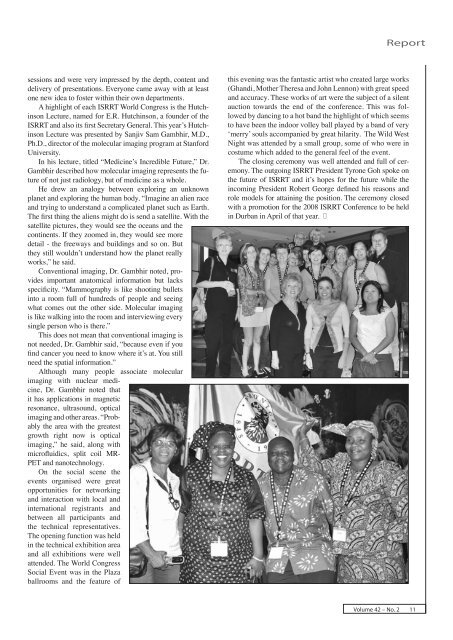ISRRT_August_2006
Create successful ePaper yourself
Turn your PDF publications into a flip-book with our unique Google optimized e-Paper software.
Report<br />
sessions and were very impressed by the depth, content and<br />
delivery of presentations. Everyone came away with at least<br />
one new idea to foster within their own departments.<br />
A highlight of each <strong>ISRRT</strong> World Congress is the Hutchinson<br />
Lecture, named for E.R. Hutchinson, a founder of the<br />
<strong>ISRRT</strong> and also its first Secretary General. This year’s Hutchinson<br />
Lecture was presented by Sanjiv Sam Gambhir, M.D.,<br />
Ph.D., director of the molecular imaging program at Stanford<br />
University.<br />
In his lecture, titled “Medicine’s Incredible Future,” Dr.<br />
Gambhir described how molecular imaging represents the future<br />
of not just radiology, but of medicine as a whole.<br />
He drew an analogy between exploring an unknown<br />
planet and exploring the human body. “Imagine an alien race<br />
and trying to understand a complicated planet such as Earth.<br />
The first thing the aliens might do is send a satellite. With the<br />
satellite pictures, they would see the oceans and the<br />
continents. If they zoomed in, they would see more<br />
detail - the freeways and buildings and so on. But<br />
they still wouldn’t understand how the planet really<br />
works,” he said.<br />
Conventional imaging, Dr. Gambhir noted, provides<br />
important anatomical information but lacks<br />
specificity. “Mammography is like shooting bullets<br />
into a room full of hundreds of people and seeing<br />
what comes out the other side. Molecular imaging<br />
is like walking into the room and interviewing every<br />
single person who is there.”<br />
This does not mean that conventional imaging is<br />
not needed, Dr. Gambhir said, “because even if you<br />
find cancer you need to know where it’s at. You still<br />
need the spatial information.”<br />
Although many people associate molecular<br />
imaging with nuclear medicine,<br />
Dr. Gambhir noted that<br />
it has applications in magnetic<br />
resonance, ultrasound, optical<br />
imaging and other areas. “Probably<br />
the area with the greatest<br />
growth right now is optical<br />
imaging,” he said, along with<br />
microfluidics, split coil MR-<br />
PET and nanotechnology.<br />
On the social scene the<br />
events organised were great<br />
opportunities for networking<br />
and interaction with local and<br />
international registrants and<br />
between all participants and<br />
the technical representatives.<br />
The opening function was held<br />
in the technical exhibition area<br />
and all exhibitions were well<br />
attended. The World Congress<br />
Social Event was in the Plaza<br />
ballrooms and the feature of<br />
this evening was the fantastic artist who created large works<br />
(Ghandi, Mother Theresa and John Lennon) with great speed<br />
and accuracy. These works of art were the subject of a silent<br />
auction towards the end of the conference. This was followed<br />
by dancing to a hot band the highlight of which seems<br />
to have been the indoor volley ball played by a band of very<br />
‘merry’ souls accompanied by great hilarity. The Wild West<br />
Night was attended by a small group, some of who were in<br />
costume which added to the general feel of the event.<br />
The closing ceremony was well attended and full of ceremony.<br />
The outgoing <strong>ISRRT</strong> President Tyrone Goh spoke on<br />
the future of <strong>ISRRT</strong> and it’s hopes for the future while the<br />
incoming President Robert George defined his reasons and<br />
role models for attaining the position. The ceremony closed<br />
with a promotion for the 2008 <strong>ISRRT</strong> Conference to be held<br />
in Durban in April of that year. <br />
Volume 42 – No. 2 11


















